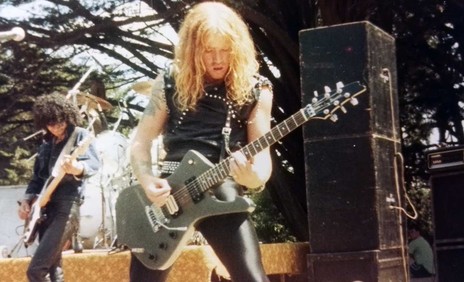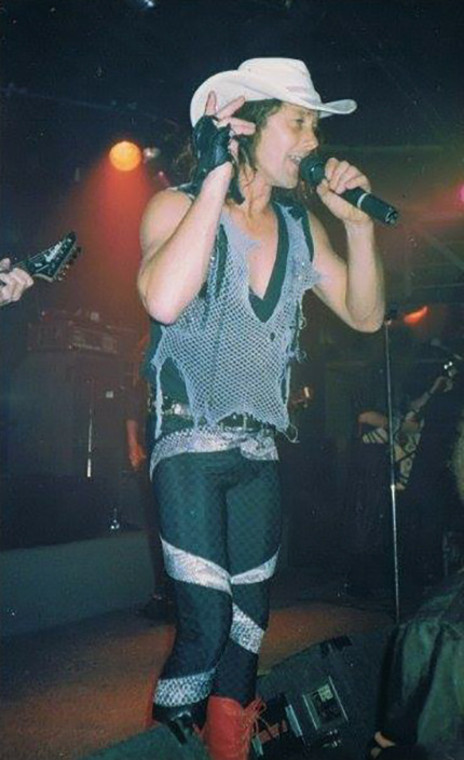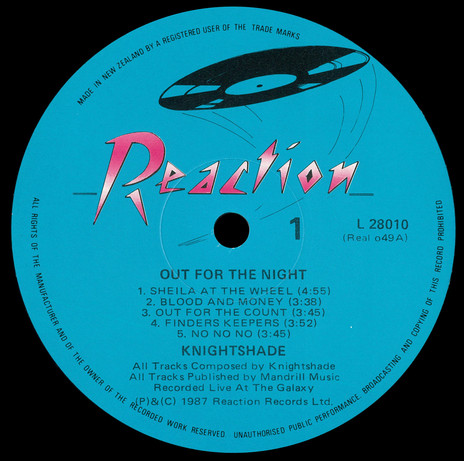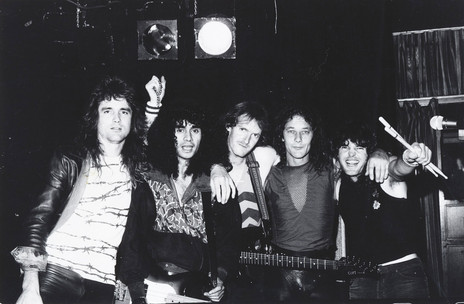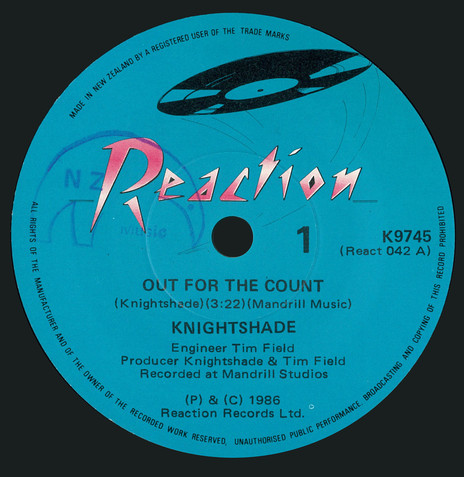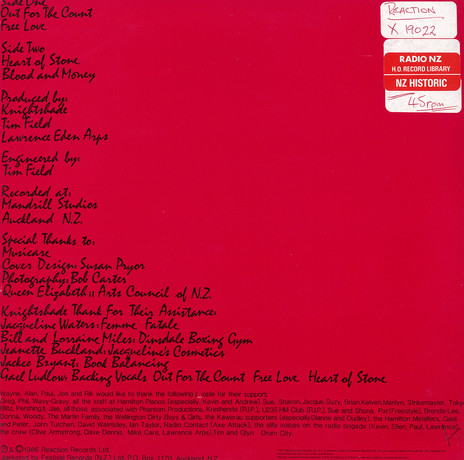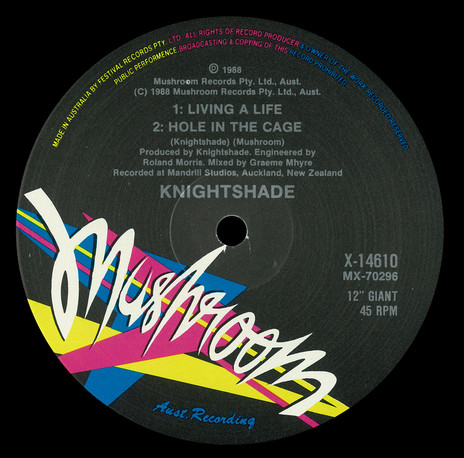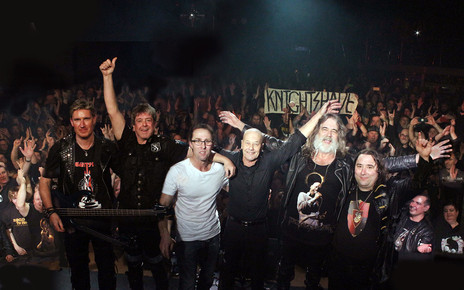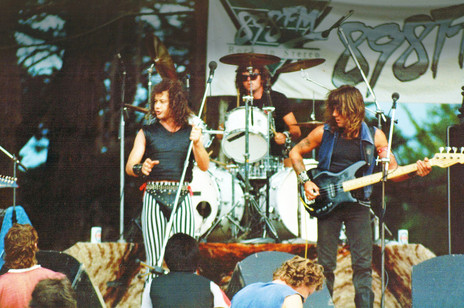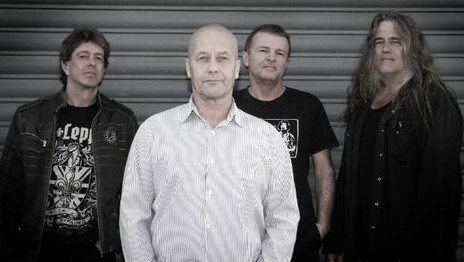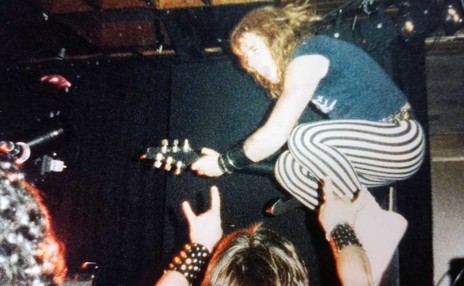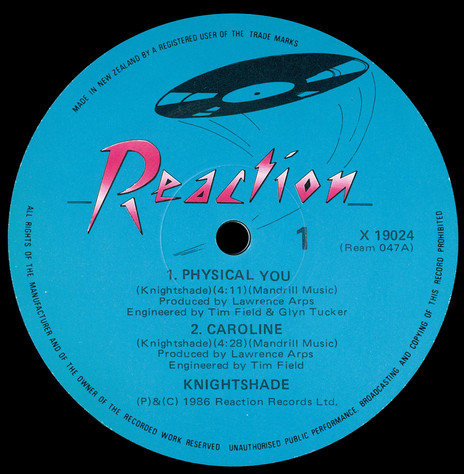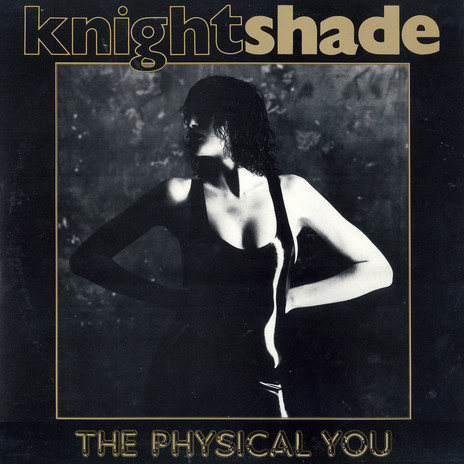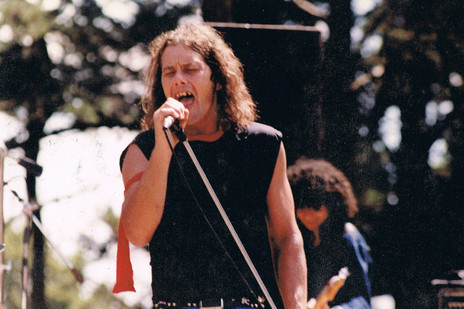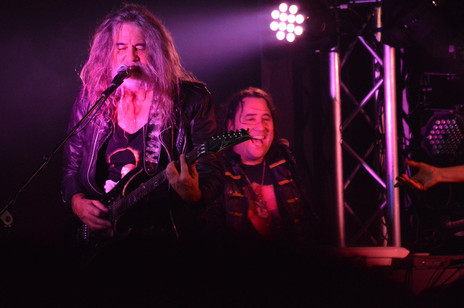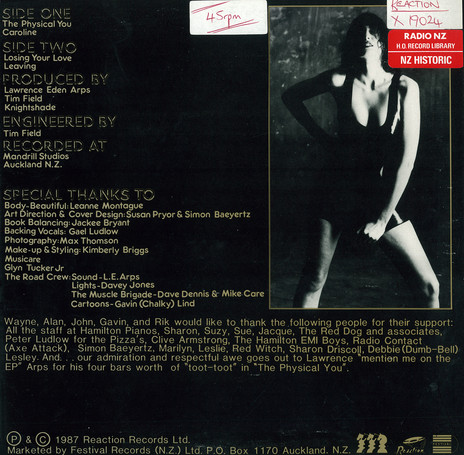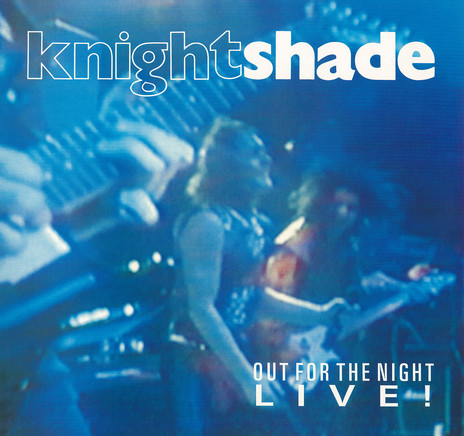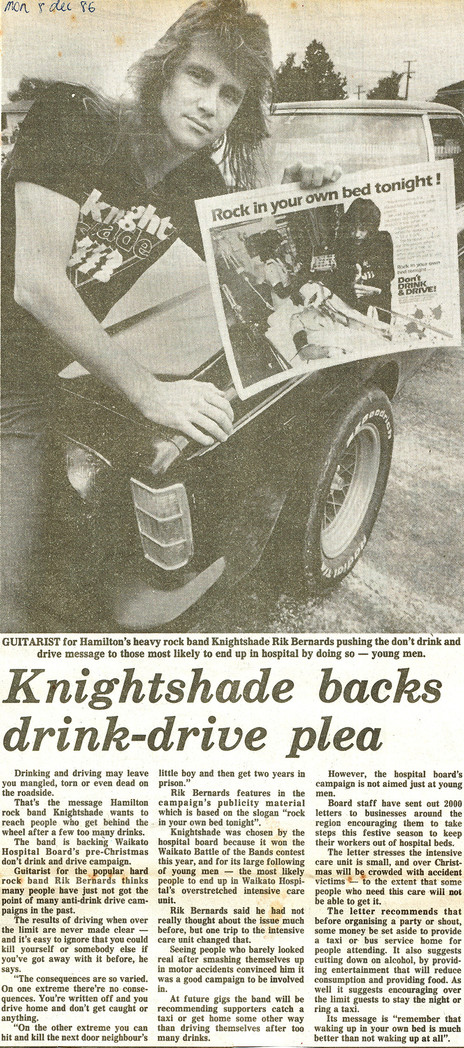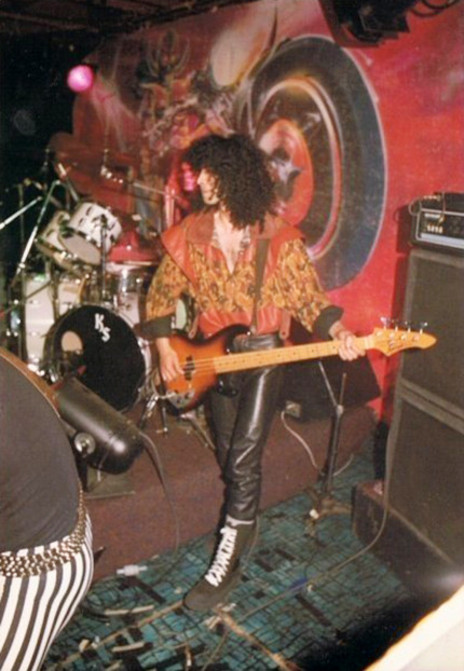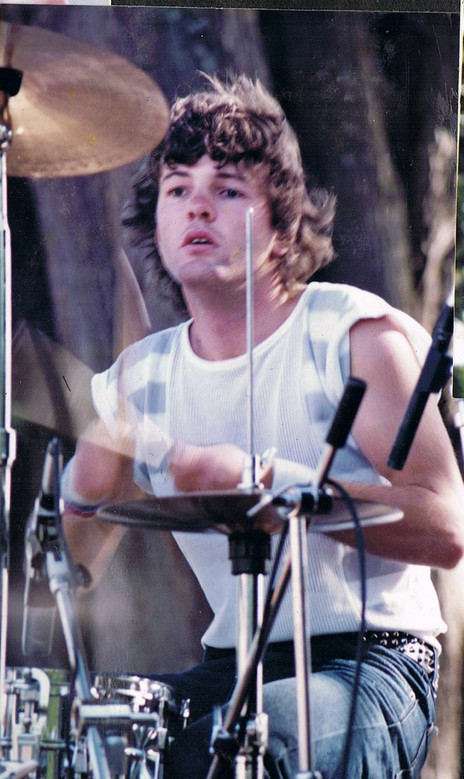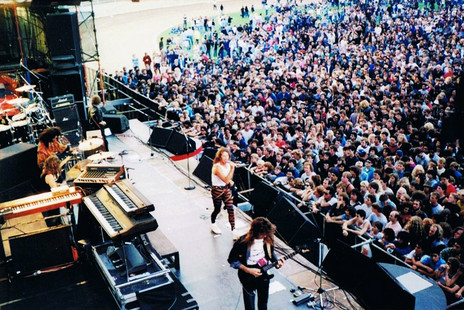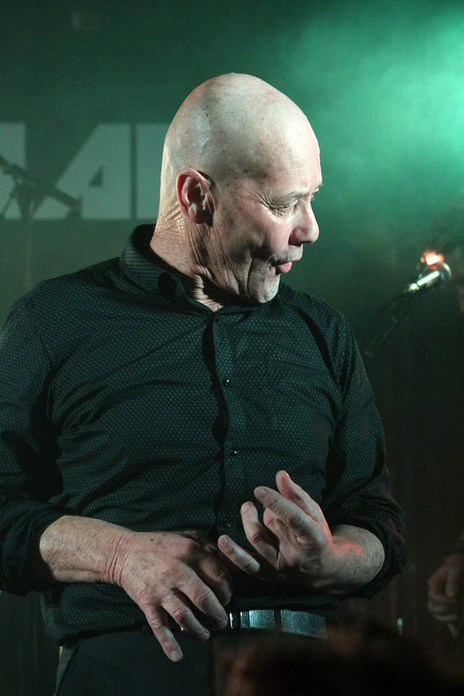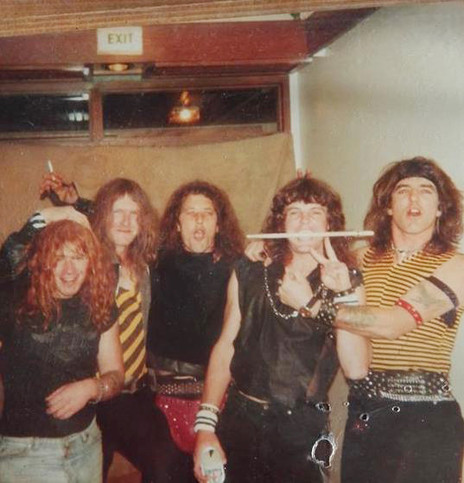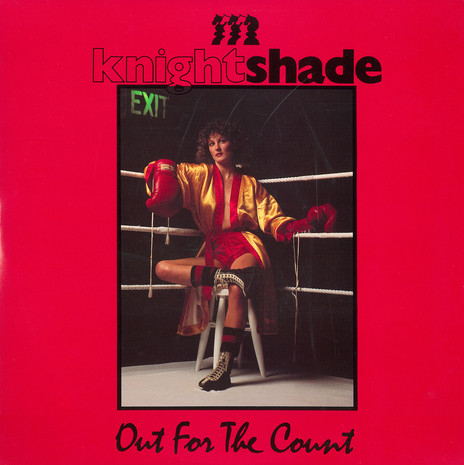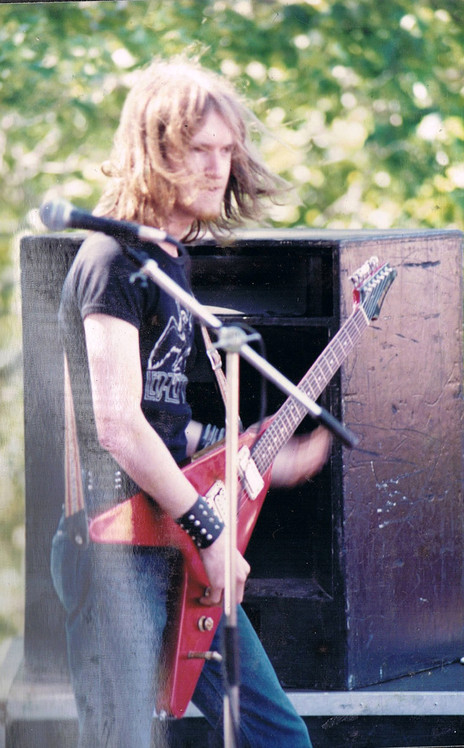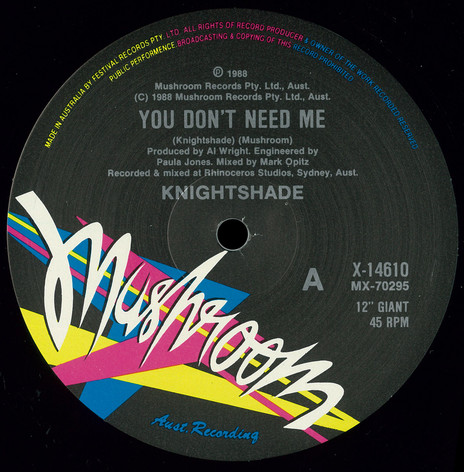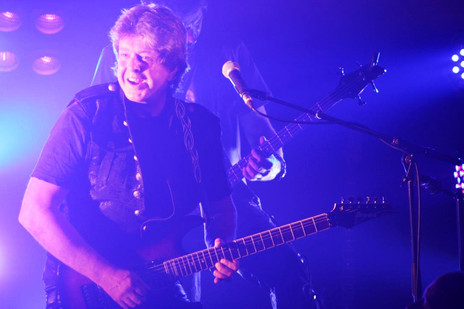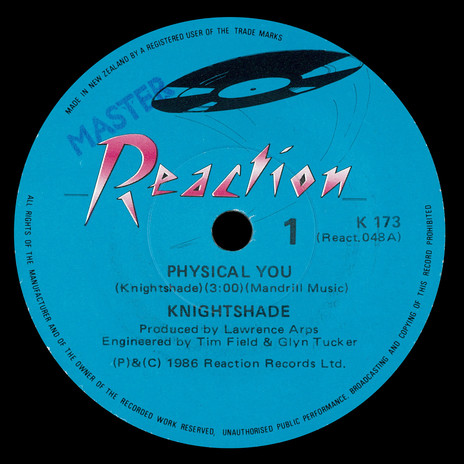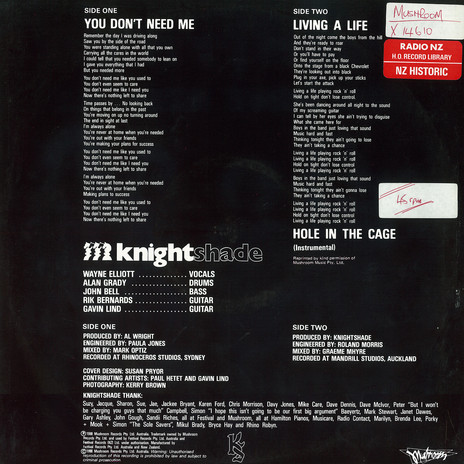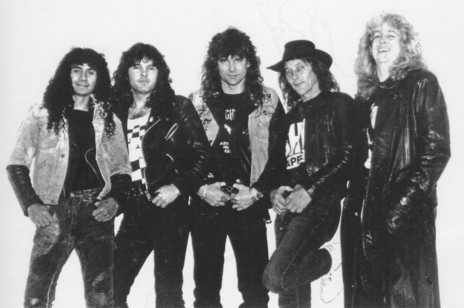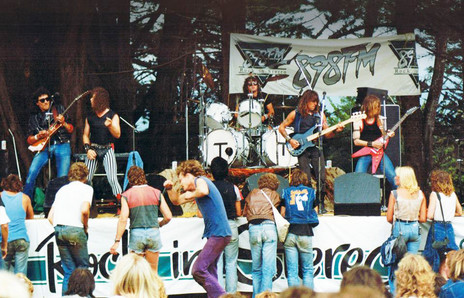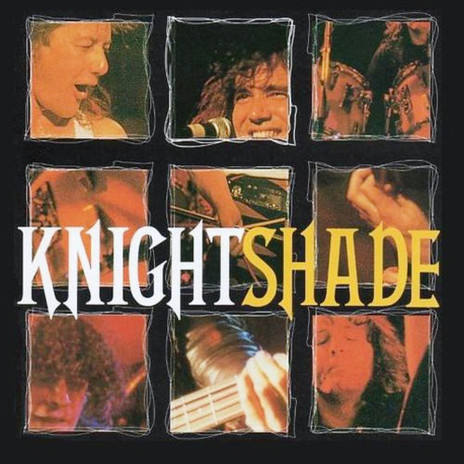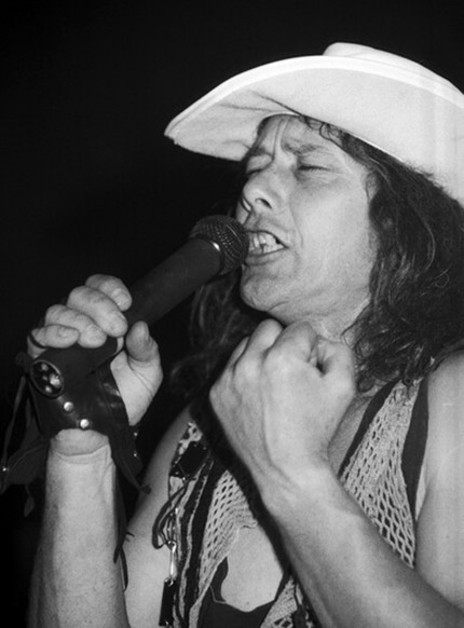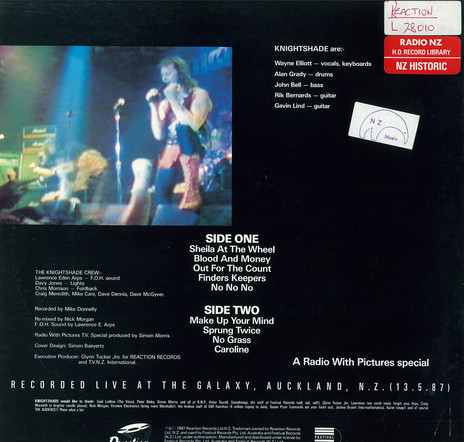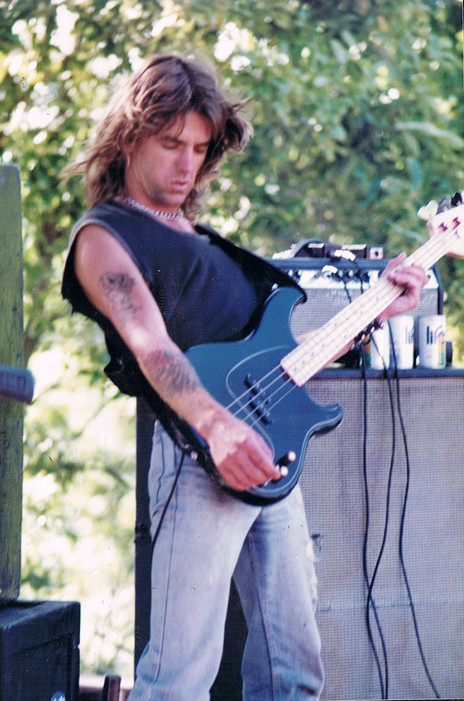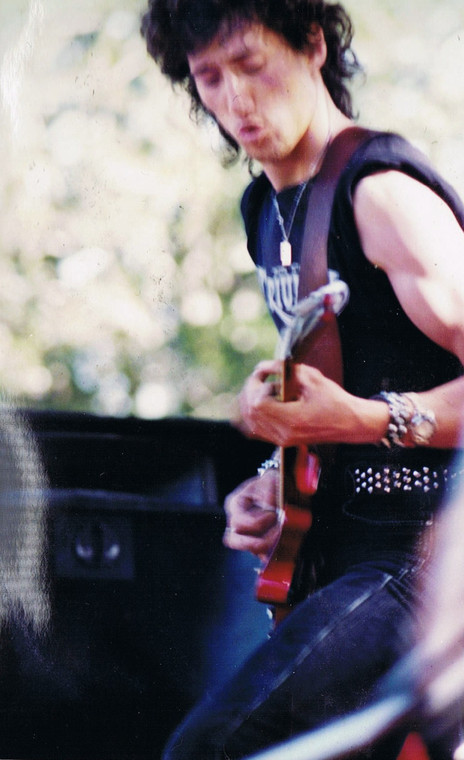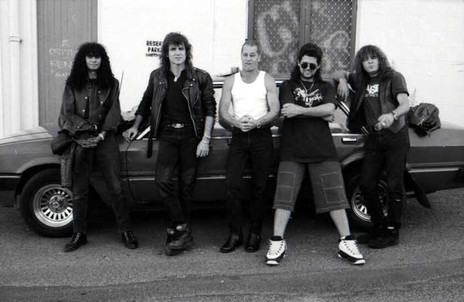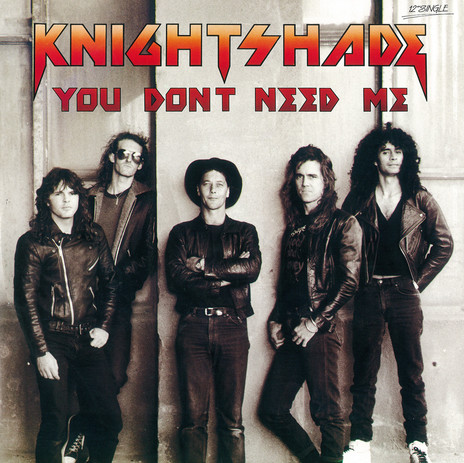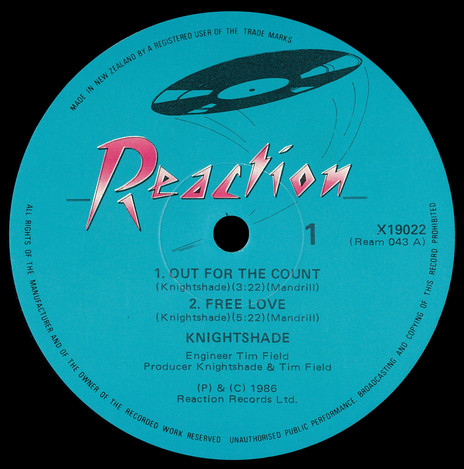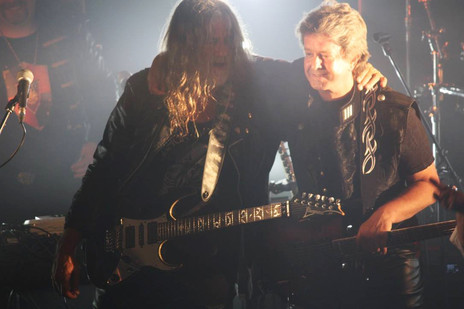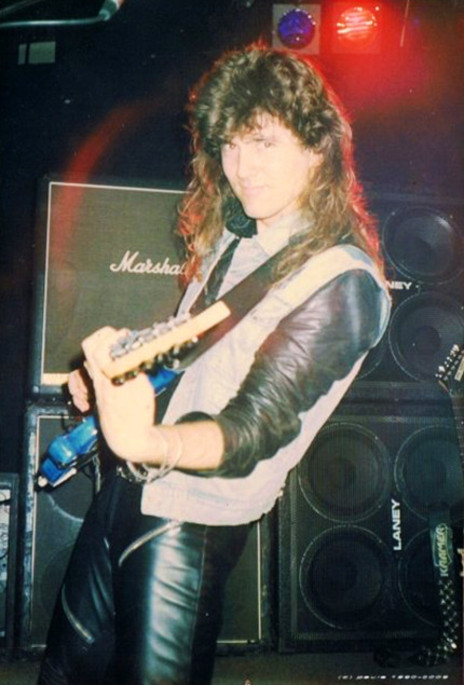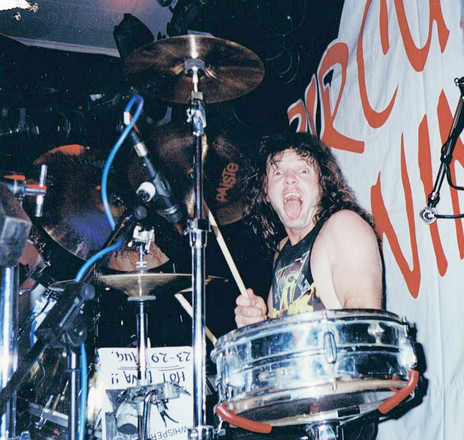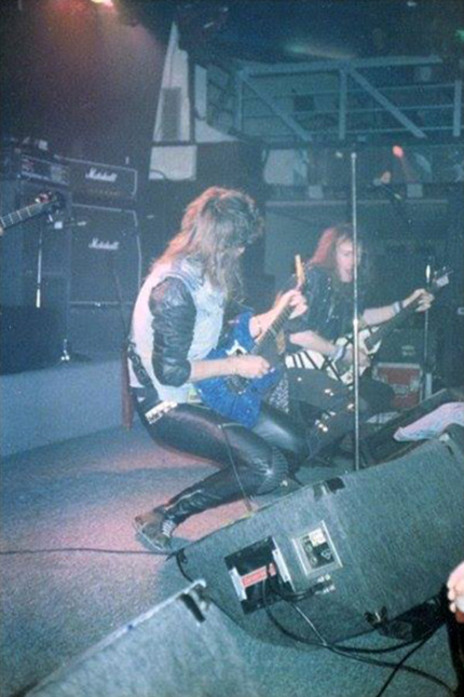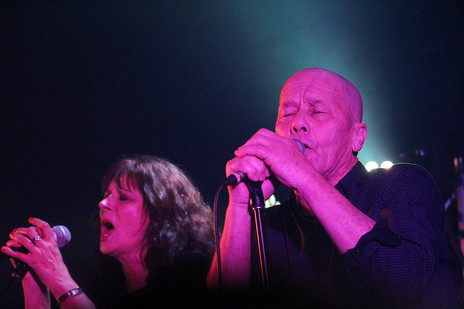Mushroom pressed them to relocate to Sydney and build an audience from scratch; Knightshade offered the label their back catalogue so they at least had product to tour. With neither party willing to budge, the band sat out the remainder of their five-year term relying on live work in New Zealand.
Although emerging with a wave of so-called heavy metal bands such as Rose Bayonet, Tyrant, Strikemaster and Tokyo – on local compilations Godzone Metal and 3 Points Of Metal – Knightshade singer Wayne Elliott told Rip It Up in 1987 that he hated the term “metal” because he believed it was derogatory.
“There are so many connotations to it, you know, you get this thump, thump headbanger bloody image and it’s not that,” he said. “You get some of the best musicians in the world playing heavy metal and you can’t get this through to people.”
Knightshade worked out early that the real money was in songwriting royalties and determined to share their publishing rights equally. Elliott penned the bones of ‘Out For The Count’ in the 15 minutes it took guitarist Rik Bernards to shoot to the dairy for milk, Bernards wrote ‘Rough At The Top’ after watching a Rugby World Cup match, drummer Alan Grady came up with the frame and catch cry of ‘Blood And Money’, and second guitarist Gavin Lind arrived at rehearsal with his paean to lady drivers ‘Sheila At The Wheel’ fully formed.
It didn’t matter who made the greater contribution to the writing, when it came to the royalty cheque it was a five-way split. That brought hefty paydays when Knightshade supported international acts such as Deep Purple, ZZ Top, Guns N’ Roses and Bon Jovi, and the entire band benefited.
Having ridden out the Mushroom contract, Knightshade finally released a studio album in 1995, on Hark Records, but called it quits the following year. There was a reunion in 2011 that health issues brought to an end – at least in terms of being a live act – with a celebratory final show in Hamilton attended by fans, former band members and contemporaries in August 2016.
ELLIOTT AND TAFT CHANCED UPON SOME TOXIC DEADLY NIGHTSHADE
The band that evolved into Knightshade was formed in Te Puke in the early 1980s as Clearlite after bass guitarist Kevin Taylor returned from Australia with an AC/DC record. The line-up was Taylor, Wayne Elliott on drums and occasional vocals, Laurie Goossens and Bobby Addison on guitars, and Ian Taft on vocals.
A name change came after Elliott and Taft were weeding an orchard and chanced upon a growth of the toxic deadly nightshade. Once Elliott had explained what it was, they agreed it would make a great band name. They put it to the rest of the guys and added the “K” as a nod to the Knights of the Round Table.
It took Taft a handful of gigs to conclude he wasn’t cut out for performing and Elliott assumed the frontman role he would come to embrace. They advertised for a drummer and Alan Grady was the successful candidate. Within the next year, Waihi guitarist Gavin Lind replaced Addison.
Building up a repertoire of their own songs while regularly gigging in the Bay of Plenty and Waikato, Knightshade approached Hamilton agent Alan Judd who booked most of the city’s bigger pubs. Even though the band refused his directive to include some Rolling Stones covers, they packed out the Hillcrest Tavern and won the agent over.
Before long they were branching out on short runs to pubs throughout the North Island. On a June 1984 trip to Wellington they played the Ascot Theatre with Strikemaster and Tokyo. TVNZ filmed the show for individual Radio With Pictures clips, and selections from each band were mixed by Ian Morris at Marmalade and released on Jayrem as 3 Points Of Metal.
With the out-of-town work becoming more frequent, Goossens opted out. Elliott put a call in to Wellington to former Tyrant guitarist Paul Martin, who packed his bags immediately. When the band commitments started encroaching on their day jobs, Knightshade came to an impasse; they had to move somewhere bigger. Taylor and Lind decided to remain in the Bay of Plenty, Elliott, Grady and Martin headed for Hamilton. While they viewed Auckland as too cliquey, Hamilton was within driving range of much of the North Island.
Settling into their new surroundings, Elliott contemplated joining local heroes The Bronx, who had released a single on Vertigo and appeared on Shazam! in 1983. He began learning their repertoire but decided it wasn’t for him and instead drafted Bronx bass guitarist Jon Bell and guitarist Rik Bernards into Knightshade – Bernards returning from a brief tenure in Strikemaster in Wellington.
The new line-up started working the traps and caught the attention of Glyn Tucker, who signed them to Mandrill Music. Knightshade’s debut EP Out For The Count was recorded during the graveyard shift at Mandrill produced by the band, engineer Tim Field and Hamilton sound man Lawrence Arps. Released on Tucker’s Reaction Records, it peaked at No.26 on the New Zealand singles chart in November 1986. The EP surprised listeners with backing vocals by TVNZ’s Our World presenter Gael Ludlow, a former bandmate of Bernards.
At the time, Reaction was marketed and distributed by Festival, and Knightshade found a true champion in company rep Simon Baeyertz. He took advantage of Festival’s alliance with Mushroom Records in Australia and organised for a Mushroom A&R person to come and check out a Knightshade gig.
As a consequence, the band looked to tighten up their sound, which was at odds with guitarist Paul Martin’s desire to lead them in a heavier direction. He was let go and Gavin Lind was brought back in time to film a Radio With Pictures special with Stonehenge at the Galaxy in Auckland in May 1987.
A second EP, The Physical You, was released in July followed a month later by a live album of the Radio With Pictures gig called Out For The Night, both on Reaction. The EP peaked on the singles chart at No.14 while the LP made it to No.37 on the album chart.
‘Out For The Night’ captured Knightshade in all its swagger, warts and all
Containing proven crowd favourites such as ‘Sheila At The Wheel’, ‘Blood And Money’, ‘Out For The Count’, and ‘Caroline’, Out For The Night captured Knightshade in all its swagger, warts and all. The band just made it off the Picton-Wellington ferry in time to get to a mate’s place in Naenae to watch the Radio With Pictures special go to air on July 12.
In the middle of all of this, the Mushroom A&R rep caught Knightshade in action at the Hillcrest and offered them a five-year deal. They flew to Sydney with the rocky ‘Television Eyes’ ready to record at producer Al Wright’s new Rhinoceros Studios, but that and every one of their harder, faster offerings was met with indifference from the A&R person. It turned out Mushroom were after a big ballad. In fact, they demanded one.
Written in the studio by Wayne Elliott and Gavin Lind, ‘You Don’t Need Me’ was mixed by Angels, Cold Chisel and Divinyls producer Mark Opitz and released in New Zealand in August 1988. It stayed on the singles chart for 11 weeks, peaking at No.14.
The video, directed by Kerry Brown and filmed between rain showers at a wet and windy Meremere Power Station, came in at a total of $84,000, of course to be recouped from band royalties. When Elliott asked for a complete breakdown of costs, one component was the retention of two hairdressers for three days. He couldn’t recall getting his hair done once.
Knightshade toured New Zealand on their own as well as support act on tours by Iggy Pop and labelmates Jimmy Barnes, Choirboys and The Angels and one-off concerts by Deep Purple, Stryper, ZZ Top, Guns N’ Roses and Bon Jovi. They partied long and hard with the Gunners and Bon Jovi, but Māori bass guitarist Jon Bell was refused entry by bouncers to the ZZ Top afterparty, so the whole band left.
Axl Rose imparted some advice to Wayne Elliott when he saw Elliott drink from a bottle offered from the audience mid-set. Rose said he had stopped doing that when he was given a bottle of urine. Knightshade also learned a valuable lesson when they had 500 band T-shirts printed for one support tour only to learn that the entire run had sold out before a power chord had even been struck and there were still five dates to go!
Mushroom wanted Knightshade to base themselves in Australia, but by now most of the band had families and weren’t keen to start again from scratch with no product to promote. And Mushroom was dead against Knightshade’s offer of their back catalogue to release and have them go on the road with.
The band’s relationship with its Australian record label was strained
The relationship with the label was strained and matters didn’t improve when they ordered another ballad in late 1989. This time Mushroom flew American producer Jim Faraci (who had worked with Poison and LA Guns) and engineer Charlie Brocco (Bernie Taupin, Robert Cray, LA Guns) to Mandrill to record ‘Last Night In The City’. Ironically it would achieve Knightshade’s highest chart position, peaking at No.9. Another track, ‘Million Dollar Love’, was recorded later but never saw the light of day.
The stalemate with Mushroom and lack of a steady income saw Gavin Lind leave in 1990 to be replaced by Craig Pollock, a former Stonehenge and Russia guitarist and Musicians Institute in Hollywood graduate. Members of Knightshade had appeared on his newly released solo album Just Looking, and with Pollock on board, Knightshade set to recording at Grant Hislop’s Zoo Studio with the intention of finally releasing an album.
The first half of the 90s was unsettled. Drummer Alan Grady spent a period in Australia while Grant Pukeroa kept his seat warm. Guitarist Rik Bernards took time off to study at Berklee in Boston and was relieved by Glenn Aitken. Pollock quit in 1994 and Simon Garlick, formerly of Auckland covers band Kick, took his spot. Bernards returned to the fold and in 1995 Knightshade released the single ‘Television Eyes’ on Hark Records, accompanied by a Greg Page directed claymation video.
Later that year came the self-titled album, also on Hark, made up of ‘Television Eyes’ and new recordings of Mushroom singles ‘You Don’t Need Me’ and ‘Last Night In The City’ and Reaction-era tracks ‘Out For The Count’, ‘The Physical You’, ‘Blood And Money’ and ‘Heart Of Stone’, as well as six newer songs that had never been committed to tape.
The long hours in the van continued, to provincial cities like Gisborne and New Plymouth, and the band always ensured the crew members were paid first. It was at a rehearsal in 1996 – following a run of gigs down the country where the promoters failed to pay a guarantee of around $10,000 – that Knightshade mainstay Wayne Elliott eyed his bandmates and declared, “Sorry, guys, I can’t do this anymore. I’ve gotta get a job.”
Some band members took up with weekend covers bands; some took up music teaching posts. Bernards later joined Ritchie Pickett in recording project The Rattler, releasing The Leaving in 2008. While enjoying a beer in a local pub one night, a stranger regaled Elliott with stories of when the stranger had been the singer in Knightshade for six months. “Oh, yeah? When was this?” inquired Elliott, not calling the punter out.
By 2011, the Knightshade fires were reigniting
By late 2011, the fires were reigniting and the Mushroom line-up of Elliott, Bernards, Jon Bell, Alan Grady and Gavin Lind reconvened to record the single ‘Rough At The Top’. By the time it was released, Bell and Lind had departed. Elliott and Bernards brought back early 90s guitarist Craig Pollock, but Grady left soon after.
With a planned return to the stage in November 2013, the band recruited two younger Hamilton players who had been influenced by Knightshade in the 1980s: bass guitarist Neil McDonald and drummer Scott Williams. But just two months out from the comeback gig, Wayne Elliott was diagnosed with the asbestos-related cancer mesothelioma and underwent surgery in December.
The show did take place in Hamilton the following June, backed up by a handful of gigs in New Plymouth, Mount Maunganui and Hamilton over the next two years. At the end of 2014 they added a permanent keyboardist in Kingsley Smith, another long-time fan. But Elliott’s continuing health problems brought an end to live work with a farewell entitled Out For The Count: Last Gig In The City, at Altitude in Hamilton on 6 August 2016. The event was filmed for a later DVD release.
In March 2017, Rik Bernards was diagnosed with throat cancer, but six months later Knightshade released the single ‘U Say’ – a big ballad Mushroom would have been proud of. With another single, ‘Paint Me Black’, almost ready to go, it just doesn’t pay to count Knightshade out.
--
It was with great sadness that the members of Knightshade and the Knightshade brigade heard that Wayne Elliott died on 4 December 2018. His bandmates paid tribute on the band’s Facebook page:
“It is with heavy hearts and deep sadness we say farewell to the man with the magic voice and founding father of Knightshade, Wayne Elliott.
“After a long and arduous five-year battle with cancer, Wayne passed away peacefully this afternoon at his home, surrounded by family and friends. All the boys in Knightshade were fortunate enough to individually spend some time with Wayne during his last months. We talked,argued, laughed, and cried about old times the way all families do! Knightshade is a family, and today we mourn the loss of our fallen comrade, our inspiration, our hero and our friend.”
“From all the boys of Knightshade, we wish to extend our heartfelt condolences to Charlie, Jed, Dale and Kate. We will all miss the man, the energy, the drive, the enthusiasm, the voice, the talent ... and ... that damned cheeky grin. You are at peace now.”
On 4 December 2019, Knightshade marked the first anniversary of Wayne Elliott with the digital release of ‘Paint Me Black’.
--
Read more: Knightshade – a photo album
